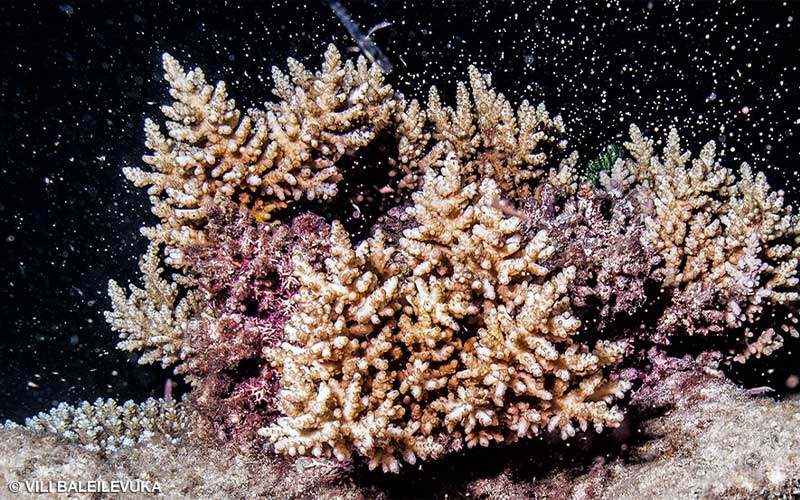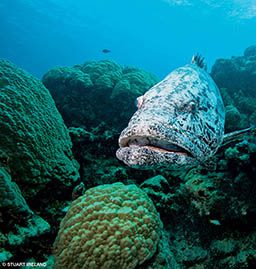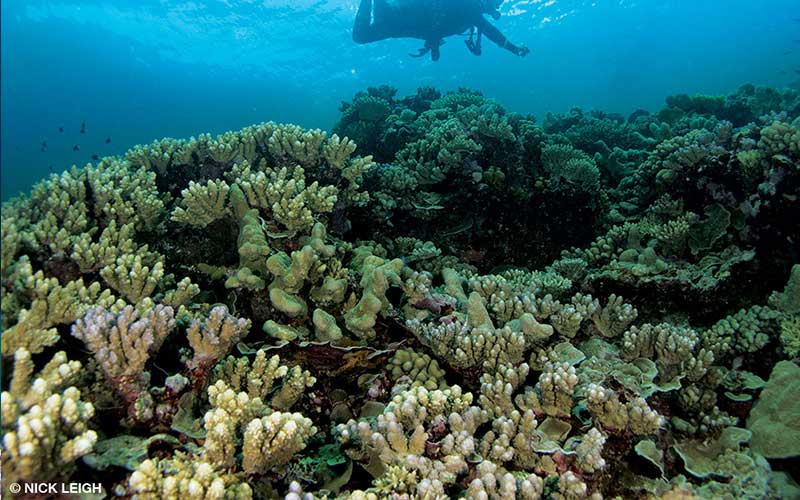The reports of its death are greatly exaggerated. Throughout 2016, news articles, including a widely read satirical obituary in Outside magazine, reported on the demise of the Great Barrier Reef (GBR). But the reef is not dead. Although in 2016 it suffered the most extensive mass bleaching event in its history, it remains one of the natural wonders of the world. If you head to Cairns or Townsville, Australia, and jump on a dive boat, you may not even notice any effects of this recent bleaching.
Like reefs around the world, the GBR is subject to a number of stressors, one of the most dominant being global climate change. If we use the recent bleaching and mortality events on the GBR as a wake-up call rather than grieving the loss of something that still exists, the reef ecosystem can repair itself. To remain optimistic, it is important to understand the difference between coral bleaching and coral mortality.
Throughout the GBR bleaching event, scientists from the Australian Research Council (ARC) Centre of Excellence for Coral Reef Studies (Coral CoE) at James Cook University, the Great Barrier Reef Marine Park Authority (GBRMPA), the Australian Institute of Marine Science (AIMS) and other partners performed aerial and extensive underwater surveys on reefs stretching the GBR’s entirety. Surveys were conducted in March and April 2016 when bleaching was at its worst (March and April are among the months with the highest ocean temperatures in the southern hemisphere) and again on the same reefs in October and November 2016 to determine how much of the bleached coral survived. Data published by the Coral CoE included the following:
- The entire reef system was not affected by the recent bleaching event. The GBR is 1,430 miles long, and its southern portion is much farther away from the equator than its northern portion. The bottom two-thirds of the reef suffered minimal to no mortality. The majority of the impact is in the northern third of the reef, a region that spans approximately 600 miles from Port Douglas to Papua New Guinea. This region is not commonly visited by recreational dive boats. Even within the northern region the overall effects of the bleaching event varied. The inshore northern section, where the water is shallower, felt the brunt of the 2016 event.
- March-April 2016 data showed the following amounts of severe bleaching in the GBR:
- 81 percent in the northern section (north of Port Douglas)
- 33 percent in the central section (Mackay north to Port Douglas)
- 1 percent in the southern section (south of Mackay)
- October-November 2016 data showed the following amounts of coral mortality in the GBR:
- 26 percent in the far north (offshore)
- 67 percent in the north
- 6 percent in the central section
- 1 percent in the south
What Is Bleached Coral?
Bleached coral is not dead coral. The bleaching data from the March-April 2016 surveys differ from the mortality data from October-November because corals can survive a bleaching event, and many of the corals on the GBR did just that.
Coral bleaching occurs when corals are stressed, in this case from high water temperatures. Corals have a mutualistic symbiotic relationship with an algae called zooxanthellae that lives within the coral tissue. Zooxanthellae use sunlight to photosynthesize food; they share this food with their coral hosts. In turn, the zooxanthellae have a safe place to live, and they receive “fertilizer” via coral waste. While corals do feed on their own, they rely on zooxanthellae to get sufficient nourishment. Zooxanthellae also give corals their color; without the algae, corals are actually clear (think of jellyfish, which are relatives of coral polyps). When subject to stress factors, the relationship between the coral and algae is damaged; without the algae, the coral tissue appears white, or “bleached.” If the temperature goes back into the preferred range within a given period, the algae will return, giving back corals their color and, more important, the food they need to survive. The coral can live only for so long without the zooxanthellae before they starve to death. The overall mortality numbers, therefore, should be the focus, but it is important to note that a coral that survives bleaching tends to be weaker and more vulnerable to diseases, has a slower growth rate and does not reproduce for one to two years.

During the follow-up surveys in November, scientists saw a lower than expected mortality rate on offshore far-north reefs. Considering 81 percent of the northern region was bleached in March, only 26 percent mortality in an area within this region is indeed good news. Coral CoE director Terry Hughes suggested that upwelling from the nearby Coral Sea cooled the water in this area.
While some corals did bleach, the mortality in the central and southern regions of the reef, the areas most visited by tourists, is so low that it will not likely be apparent to most visitors. In the central region, 33 percent of the corals had bleached, but only 6 percent of the corals died. At this point, the zooxanthellae have returned to the majority of the corals that bleached, giving the coral its color once again. If diving the GBR is on your bucket list, you are in luck. A weather anomaly spared the reef from much greater damage. A cyclone that passed over Fiji in February 2016 transitioned to a rain depression that hit the southern coast of Queensland and cooled the southern half of the GBR, sparing that section the extent of bleaching and mortality found further north.
What Caused the 2016 Bleaching?
Corals are extremely particular in terms of the environmental parameters in which they can survive. Stable environmental conditions, specifically in regard to water temperature, salinity and low nutrient levels, are imperative for a healthy coral reef. Corals have a preferred temperature range in which they can thrive. If the water gets too warm or too cold, the corals stress.

Our oceans are warming, and human-induced global climate change is to blame. As we add greenhouse gases to the atmosphere, the Earth is getting warmer. The oceans absorb more heat as a result, and we are seeing a steady increase in sea surface temperature. The U.S. National Oceanic and Atmospheric Administration (NOAA) indicates that sea surface temperature has increased at a rate of 0.13°F per decade since 1901. While this increase may seem slight, for animals such as corals, which have a 10-degree (°F) temperature window in which they can survive, a degree or even less can be the difference between life and death.
According to the Australian Bureau of Meteorology, in 2016 the GBR recorded its hottest average sea surface temperatures for February, March, April, May and June since records began in 1900. In 2015 and 2016 the waters off Australia experienced an El Niño event in addition to the warming ocean temperatures. El Niño is a climate pattern that describes the unusual warming of sea surface waters in the eastern tropical Pacific Ocean. El Niño events can occur every two to seven years, but they are not regular or predictable, and their intensity can vary. This combination of El Niño and warmer seas precipitated the 2016 mass coral bleaching event.
Will Mass Coral Bleaching Happen Again?
In 1997 and 1998 an El Niño and bleaching event occurred; it was the first mass bleaching event on the GBR. Another mass bleaching event on the GBR occurred in 2002. Both events resulted in 50-60 percent bleaching, but less than 5 percent of the reefs experienced high coral mortality. A 2016 AIMS study conducted between 2012 and 2015 found that these areas not only recovered, but there was also an overall 19 percent increase in coral cover in the southern GBR. The reefs have proven resilient in the past, and the hope is that the northern corals affected in 2016 will follow suit and return to predisturbance status in the next 10-15 years.
Bleaching, of course, is not unique to the GBR. In 2015 a study was published that examined the resilience of corals in the Seychelles affected by the 1998 mass bleaching event. While 90 percent of the coral cover was lost from this event, 12 of the 21 surveyed reefs recovered to their predisturbance status. The resilient reefs had the highest structural complexity and were generally deeper but also had decreased nutrient levels (i.e., decreased pollution, better water quality) and healthy fish populations (no overfishing).
Reef resilience seems to be dependent largely on healthy, coral-dominated reef systems. Like reefs throughout the world, the GBR is experiencing numerous stresses in addition to global climate change. To build reef resilience against future climactic events, we should concentrate on decreasing local threats. The GBRMPA lists local threats to the GBR as coastal development, declining water quality from land runoff and fishing impacts. Corals weakened by threats such as these are less likely to be resilient when the next climactic event happens.
El Niño events will continue to occur, and unless humans around the world make some aggressive changes toward reducing climate-changing emissions, the ocean’s baseline temperatures will continue to rise. The best prevention against mass mortality is resilience to warm water. Healthy corals are resilient, and though they may bleach as a result of El Niño, healthy corals have the greatest chance of survival.

Where Do We Go from Here?
The GBR remains an amazing dive site for visitors from around the globe to enjoy. The annual coral spawning generally occurs along the GBR after the new moon in October or November. While the northern section did not have a normal full spawn, the mass spawning event on the GBR did occur in November 2016, including on reefs in the far-north region. This is an important note, because corals that are in a weakened or stressed state will not put energy toward reproduction.
Some corals are more resistant to bleaching than others. Research is ongoing to identify the genotypes of the most resilient corals (see “The Restoration Revolution” at http://www.alertdiver.com/restoration_revolution). These extremely resilient corals may be the ones that rebuild the reef.
The bleaching of the GBR received considerable media attention, but similar mass bleaching events are occurring on reefs across the world. This should incite greater awareness of global coral reef issues. What can you do to make a difference? Try swapping out your car for a bike every once in a while. Recycle. Buy local. Use public transportation. Unplug your charger when you’re not using it. Plant a tree. And, of course, go dive. Maybe even visit that bucket list destination, the GBR. As long as dive tourism is a serious source of revenue, other exploitative and extractive uses of the reef will meet with resistance.
| © Alert Diver — Q1 2017 |